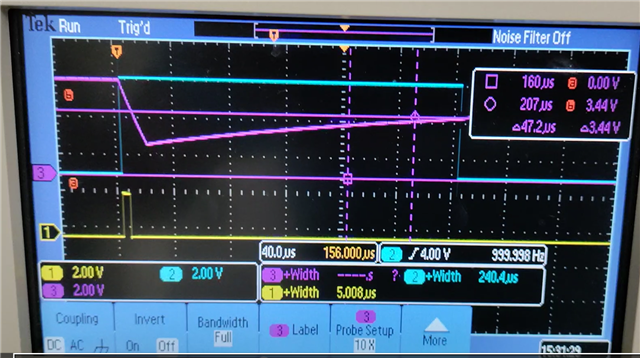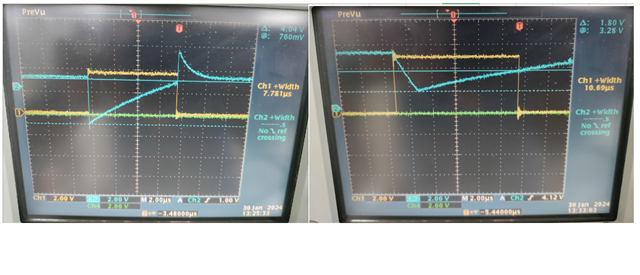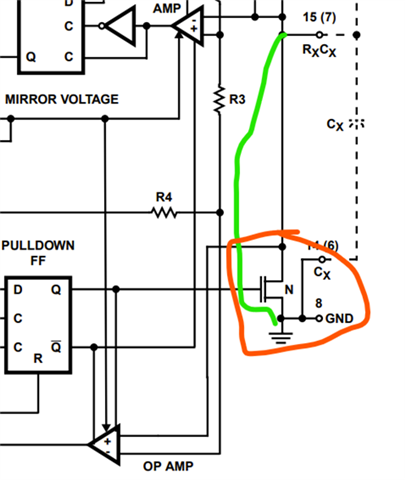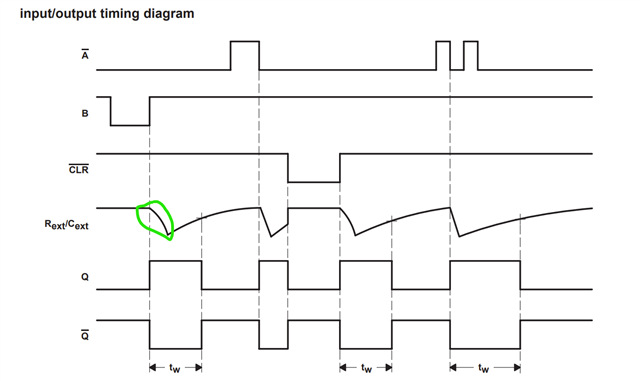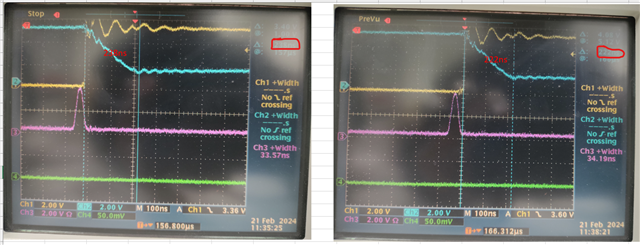Other Parts Discussed in Thread: SN74221, SN74LV221A
I did replace U1 IC from SN74221NE4 to CD74HCT221, one of the reasons is SN74221NE4 part output signal varies a lot based on the input trigger frequency.
One problem solved specifically related to TP32, which is pretty much consistent with CD74HCT221 part, output signal variations is within 8us at TP32 compared to ~36us variations on previous part SN74221NE4.
Reason for reaching out : at TP27 output, theoretical calc does not match with the measured values (capture below at point 4), atleast want to have kind of justification why it does not match.
In the following circuit, with R56 = 1.21K ohm and C26 = 0.01uf, pulse width calculations done per 0.7 x R X C.
Considering tolerance of the Resistor and the capacitor, theoretical calculations shown TP27 min, typical and max in bold font herewith
| Min | 7.64E-06 |
| Typical | 8.47E-06 |
| Max | 9.34E-06 |
1.) On a bare IC : pin6 and pin14 CX pins on this IC CD74HCT221 were shorted to ground pin8, this seems expected from the functional diagram, once trigger is received Cext cap discharges via internal MOSFET.
where as the previous part SN74221NE4 pin6 and pin14 CX pins does not have short to pin 8 ground.
2.) I am trying to see the output pulse width at TP27 variation based on the components R, C tolerances and also based on IC output tolerance itself
3.) I think CD74HCT221 IC has 2% output tolerance, in my calculations I have considered 7% (based on previous part SN74221NE4 data spec), definitely not logical, but I can update it to 2% based on feedback/comments
| R56 | 1% TOL | Considering tolerances of R and C values | ||||||||
| 1210 | 12.1 | 1197.9 | 1222.1 | ln2 | R56 | C26 | ||||
| 0.7 | 1.21E+03 | 1.00E-08 | 8.47E-06 | |||||||
| C26 | 2% TOL | 0.7 | 1.20E+03 | 9.80E-09 | 8.22E-06 | |||||
| 1.00E-08 | 2.00E-10 | 9.8E-09 | 1.02E-08 | 0.7 | 1.22E+03 | 1.02E-08 | 8.73E-06 | |||
| Considering tolerance of IC itself | ||||||||||
| Min | 7.64E-06 | 7.64E-06 | 7.88E-06 | 8.11E-06 | ||||||
| Typical | 8.47E-06 | 8.22E-06 | 5.75E-07 | 8.47E-06 | 5.93E-07 | 8.73E-06 | 6.11E-07 | |||
| Max | 9.34E-06 | 8.79E-06 | 9.06E-06 | 9.34E-06 | ||||||
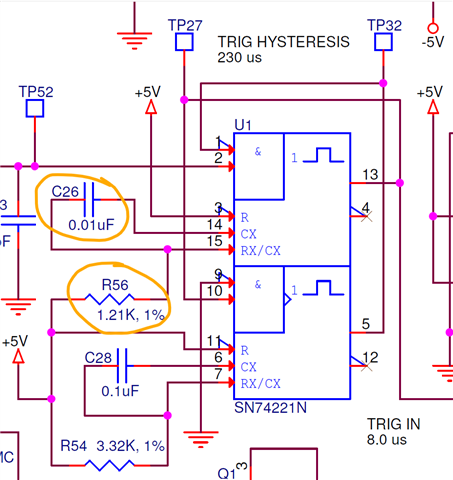
Point 4: Measured width at the output pin at TP27 is 10.69 us?
Overall at TP27 this device CD74HCT221 really consistent in its output pulse width of 10.7us irrespective of trigger frequency(PIN 2) of 1 to 4khz.
point 5 : typical theoretical calc came around 8.4us, which pretty much does match with the charge timing of the capacitor right after the first ~2us of discharge period
How to interpret this behavior as the output timing at TP27 does not match with theoretical calc values?
In the following as soon as the trigger is received at pin 2, the multivibrator output TP27(Ch1) goes high and the pin15(ch2,blue) scope capture shows it starts discharging, In general the cap should discharge very fast compared to ~2us in this case? any comments about the reason?
In the following screen shot : ch1 is the TP27 and Ch2(blue) is pin 15(Rx/Cx) of IC U1 CD74HCT221
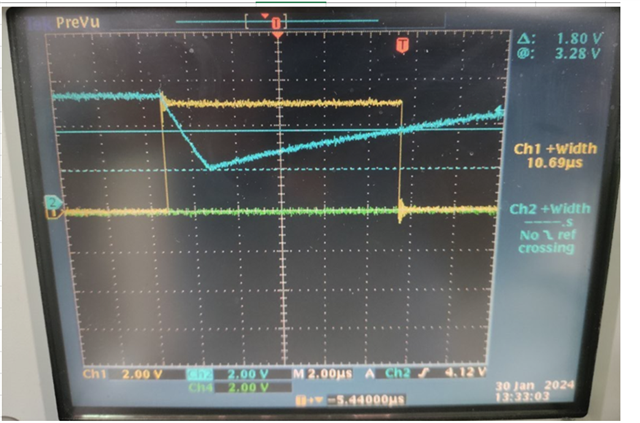
Point 6:
In the following image, I captured for the second section of the multivibrator,
ch1 is the trigger signal at pin 2
ch2(blue) is the output signal at pin 5,
ch3(purple) is at the pin 7(Rx/Cx)
As this second multivibrator set to 230us, overal pulse width observed is 240us, out of which the discharge time of the capacitor is observed as ~16us.
I did not want to confuse with this extra dataset :-) . Seems like based on the set RC timings, the discharge time does vary ?
I could not paste the image in this window, attaching it at the end of this request , named as image for point 6.
Overall at TP32 this device CD74HCT221 really consistent in its output pulse width +/- 8us between trigger frequency of 1 to 4khz.
| Min | 233us |
| Max | 241us |
Image for point 6
